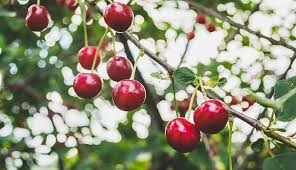Cherry Farming – Guidance About Planting the Cherry

Cherry trees are worth visiting in the spring when they are covered with white or pink flowers. After that, they produce the delicious cherries that most people like to eat.
- Sweet cherries are the variety most often found in markets. They have a rich, thick, and almost plumb-like texture. Sweet cherries grow in hardiness zones 5 through 7; They are self-sterile and best for a large garden. Farmers will need at least two or three trees, as they will need to pollinate each other. If space is limited, consider the dwarf, self-pollinating variety ‘Stella’.
- Sour cherries are not typically eaten raw but are widely used for preserves, and other cooking uses. Sour cherries are much smaller than sweet cherries, and all varieties are self-fertile. They grow in zones 4 to 6.
Cherry trees usually begin to bear fruit in their fourth year; Dwarf trees bear fruit a year earlier. A mature, standard-sized tart or sweet cherry tree produces 30 to 50 quarts of cherries each year; A dwarf tree, 10 to 15 quarts about. After flowering in the fruiting year, you will need to cover the trees with wildlife-safe netting to protect the fruit from birds.
Cherry Farming – Suitable Soil/Land Preparation:-
- For better growth and higher yield, if there is cherry, then you should select proper soil.
- Cherry trees require deep sandy loam soil with a pH range of 6.0 to 7.5.
- good moisture-holding capacity with well-drained fertile soil is best for cherry cultivation.
- Since cherry trees are sensitive to water stagnation, it is essential to ensure that the soil has internal drainage.
- Avoid heavy soil in cherry fruit or cherry cultivation.
Cherry Farming – Fertilizers and Nutrition requirements:-
Cherry plants require good organic and inorganic fertilizers for quality fruit sets. In the case of the full-grown cherry tree, at 1 year of age for better yield and quality, application of 10 kg of field manure, 200 g nitrogen, 160 g phosphate, and 100 g potash per cherry tree is recommended.
Water supply/Irrigation:-
- Cherry is grown in India under rainfed conditions.
- However, in areas where annual rainfall is low and uneven rainfall is expected, the cherry plants need frequent irrigation to maintain the moisture content of cherry plants.
- We need to irrigate the Cherry trees at weekly intervals for better fruit quality and size, especially at fruit development.
- Irrigation should be done in hot weather climatic conditions like April to May.
- Drip irrigation can be good as the best water management practice.
Cherry Farming – Planting Of Cherries:-
- When the soft ground has a higher moisture content, you should plant the cherries in the late fall or early spring.
- Ensure the different varieties will pollinate each other for sweet cherries.
- Planting the plant in a sunny place with good air circulation; avoid planting near shady trees or buildings.
- Cherry trees need deep, well-draining soil.
- Sweet cherries distance should be approx 35 to 40 feet in such a way Dwarfs distance 5 to 10 feet.
- Similarly, Space tart cherry keeps the distance 20 to 25 feet; Dwarfs distance 8 to 10 feet.
- Plant the tree on standard rootstocks with the graft union a few inches below soil level. Plant the tree on a dwarf rootstock with the graft union several inches above soil level.
- When planting a fan-trained tree, build up the necessary support before planting. For example, install fans only at a distance of 12 to 15 feet.
- Place the rootstock on a short mound of soil in the center of the planting hole and spread the roots away and down, trying not to twist the roots for Beirut trees.
- For container-grown trees, first, remove the root ball and its edge; Cut the roots with scissors.
Care of the Cherries in Procedure of Cherry Farming:-
- There is no difference in the care of sour and sweet cherries.
- Apply mulch to retain moisture.
- To protect the fruits from birds, lay nets on the trees.
- Water regularly in dry areas.
- Thinning the fruit is not necessary for cherry trees, as they usually thin naturally in early summer.
- Prune trees each year in late winter to encourage the growth of new fruiting wood. Do not prune in the fall.
- Fertilize each spring until the trees begin to tolerate, then fertilize only after harvesting each season.
Cherry Farming – Harvest / Storage
- Pick fruit only when fully ripe (dark red, black, yellow); The amount of sugar increases a few days before it is fully ripe.
- Be ready to harvest within a week. Eat or cook immediately.
- Pick fruits when they are about to freeze.
- Picking by hand can injure the twigs and lead to infection; Cut off the stalk with scissors.
- Remember that cherry trees do not produce fruit until their fourth year. After that, they should produce about 30 to 50 quintals of cherries every year.
In the guidance of Cherry farming, we can guide the agriculture equipment, such as tractor, implements, harvesters. Now we are guiding about tractors. For Cherry farming, Powertrac Euro 50 tractor is the best in fieldwork. Along with this, we can suggest an Eicher 380 tractor.
For more information regarding Cherry farming, stay tuned with us.




